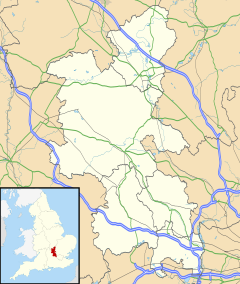world.wikisort.org - United_Kingdom
Gayhurst is a village and civil parish in the unitary authority area of the City of Milton Keynes, Buckinghamshire, England.[2] It is about two and a half miles NNW of Newport Pagnell.
This article needs additional citations for verification. (August 2010) |
| Gayhurst | |
|---|---|
 Gayhurst Location within Buckinghamshire | |
| Population | 128 (2011 Census)[1] |
| OS grid reference | SP849466 |
| Civil parish |
|
| Unitary authority | |
| Ceremonial county | |
| Region | |
| Country | England |
| Sovereign state | United Kingdom |
| Post town | NEWPORT PAGNELL |
| Postcode district | MK16 |
| Dialling code | 01908 |
| Police | Thames Valley |
| Fire | Buckinghamshire |
| Ambulance | South Central |
| UK Parliament |
|
The village name is an Old English language word meaning 'wooded hill where goats are kept'. In the Domesday Book in 1086 it was recorded as Gateherst; later names include Goathurst.[3] At that time the manor was owned by Bishop Odo of Bayeux.[3]
Gayhurst had an outstation from the Bletchley Park codebreaking establishment, where some of the Bombes used to decode German Enigma messages in World War Two were housed.[citation needed]
In 1582, Queen Elizabeth I made a grant of Gayhurst Manor "in the event of its reversion to the Crown" to Sir Francis Drake,[3] but there is no record that he ever received it. The house once belonged to Sir Everard Digby (1578–1606),[4] one of the conspirators in the Gunpowder Plot of 1605.[3] His son Sir Kenelm Digby,[5] (1603–1665) was an English courtier, diplomat, natural philosopher and astrologer. He was born at Gayhurst.
The church of St Peter was built in the classical style in 1728 to replace a medieval church; the designer is unknown.[6]
References
- UK Census (2011). "Local Area Report – Gayhurst (E04001254)". Nomis. Office for National Statistics. Retrieved 18 November 2019.
- "Contact your Parish, Town or Community Council". Milton Keynes Council. Retrieved 10 October 2020.
- William Paige, ed. (1927). "Parishes : Gayhurst". A History of the County of Buckingham. Victoria History of the Counties of England. Vol. 4. Constable & Co. Ltd. pp. 343–347.
- Yorke, Philip Chesney (1911). . Encyclopædia Britannica. Vol. 8 (11th ed.). pp. 260–261.
- Yorke, Philip Chesney (1911). . Encyclopædia Britannica. Vol. 8 (11th ed.). pp. 261–262.
- Betjeman, J. (ed.) (1968) Collins Pocket Guide to English Parish Churches: the South. London: Collins; p. 127
Другой контент может иметь иную лицензию. Перед использованием материалов сайта WikiSort.org внимательно изучите правила лицензирования конкретных элементов наполнения сайта.
WikiSort.org - проект по пересортировке и дополнению контента Википедии